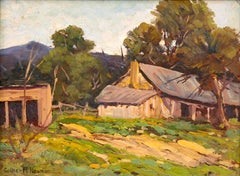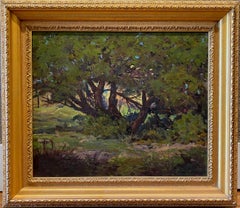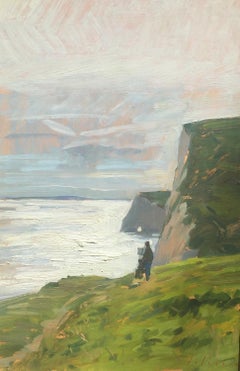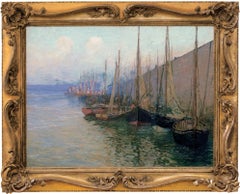Gilbert Neumann Art
American, 1906-1970
Gilbert Franz Neumann (1906-1970) was an Early Texas Plein Air painter and native of San Antonio Texas. He was a student of Jose Arpa, and exhibited his works in San Antonia throughout the 1920's and 30's. During the Great Depression he was hired by a government art program to paint the mural, titled "Autumn" at Robert B. Green Hospital in San Antonio. He worked with photographer Ernest Raba to found a find arts school, and taught at Leon Springs Art Colony, near San Antonio.
In the 1940's Neumann lived in California. He later, moved back to San Antonio where he spent the rest of his life.
Naumann's exhibits include the Edgar B. Davis competition in 1927 and 1929; and exhibit of Jose Arpa's students at the Witte Museum, San Antonio: the San Antonio Artists Guild: Annual Texas Artists Exhibition in Fort Worth; and the Dallas Woman's Forum.
Nin the Edgar B. Davis competitions In 1927 and 1929. An exhibit at the Witte Museum of Jose Arpa and his students; San Antonio Artists Guild: The Annual Texas Artists Exhibition in Fort Worth; The Dallas Woman's Forum and others.(Biography provided by Austin Galleries)
to
2
2
1
2
1
1
Overall Height
to
Overall Width
to
2
1
1
1
1
1
2
1
2
6,938
3,292
2,514
1,213
2
2
1
Artist: Gilbert Neumann
Old House, Built in 1848
By Gilbert Neumann
Located in Austin, TX
"Old House, Built in 1848" by painter Gilbert F. Neumann
Medium: Oil paint on panel
Size: 9 x 12 inches
Frame Size: 14 x 18.5 inches
A nostalgic painting of ...
Category
20th Century American Impressionist Gilbert Neumann Art
Materials
Panel, Oil
"TEXAS DENSITY" TREES, CACTUS, TEXAS HILL COUNTRY
By Gilbert Neumann
Located in San Antonio, TX
Gilbert Neumann
(1906 - 1970)
San Antonio Artist
Image Size: 20 x 24
Frame Size: 28 x 32
Medium: Oil
"Texas Density"
Gilbert Neumann, a native of San Antonio, was one of Jose Arpa's ...
Category
1950s Impressionist Gilbert Neumann Art
Materials
Oil
Related Items
Painter on the Jurassic Coast
By Marc Dalessio
Located in Sag Harbor, NY
Painted en plein air on the cliffs of England, Dalessio captures a painter painting along the cliff-line.
Marc Dalessio was born in 1972 in Los Angeles, C...
Category
2010s American Impressionist Gilbert Neumann Art
Materials
Panel, Oil
"In Port"
By Edward Willis Redfield
Located in Lambertville, NJ
Jim’s of Lambertville is proud to offer this artwork by:
Edward Willis Redfield (1869 - 1965)
Edward W. Redfield was born in Bridgeville, Delaware, moving to Philadelphia as a young child. Determined to be an artist from an early age, he studied at the Spring Garden Institute and the Franklin Institute before entering the Pennsylvania Academy from 1887 to 1889, where he studied under Thomas Anshutz, James Kelly, and Thomas Hovenden. Along with his friend and fellow artist, Robert Henri, he traveled abroad in 1889 and studied at the Academie Julian in Paris under William Bouguereau and Tony Robert-Fleury. While in France, Redfield met Elise Deligant, the daughter of an innkeeper, and married in London in 1893.
Upon his return to the United States, Redfield and his wife settled in Glenside, Pennsylvania. He remained there until 1898, at which time he moved his family to Center Bridge, a town several miles north of New Hope along the Delaware River. Redfield painted prolifically in the 1890s but it was not until the beginning of the twentieth century that he would develop the bold impressionist style that defined his career. As Redfield’s international reputation spread, many young artists gravitated to New Hope as he was a great inspiration and an iconic role model. Edward Redfield remained in Center Bridge throughout his long life, fathering his six children there.
Around 1905 and 1906, Redfield’s style was coming into its own, employing thick vigorous brush strokes tightly woven and layered with a multitude of colors. These large plein-air canvases define the essence of Pennsylvania Impressionism. By 1907, Redfield had perfected his craft and, from this point forward, was creating some of his finest work.
Redfield would once again return to France where he painted a small but important body of work between 1907 and 1908. While there, he received an Honorable Mention from the Paris Salon for one of these canvases. In 1910 he was awarded a Gold Medal at the prestigious Buenos Aires Exposition and at the Panama-Pacific Exposition of 1915 in San Francisco, an entire gallery was dedicated for twenty-one of his paintings.
Since Redfield painted for Exhibition with the intent to win medals, his best effort often went into his larger paintings. Although he also painted many fine smaller pictures, virtually all of his works were of major award-winning canvas sizes of 38x50 or 50x56 inches. If one were to assign a period of Redfield’s work that was representative of his “best period”, it would have to be from 1907 to 1925. Although he was capable of creating masterpieces though the late 1940s, his style fully matured by 1907 and most work from then through the early twenties was of consistently high quality. In the later 1920s and through the 1930s and 1940s, he was like most other great artists, creating some paintings that were superb examples and others that were of more ordinary quality.
Redfield earned an international reputation at a young age, known for accurately recording nature with his canvases and painting virtually all of his work outdoors; Redfield was one of a rare breed. He was regarded as the pioneer of impressionist winter landscape painting in America, having few if any equals. Redfield spent summers in Maine, first at Boothbay Harbor and beginning in the 1920s, on Monhegan Island. There he painted colorful marine and coastal scenes as well as the island’s landscape and fishing shacks. He remained active painting and making Windsor style furniture...
Category
Early 1900s American Impressionist Gilbert Neumann Art
Materials
Canvas, Oil
"Winter Storm, NYC"
By Johann Berthelsen, 1883-1972
Located in Lambertville, NJ
Jim’s of Lambertville Fine Art Gallery is proud to offer this piece by Johann Berthelsen (1883 – 1972).
Born in 1883 in Denmark to artistically inclined parents, Johann Berthelsen would become a widely successful singer, teacher, and painter. After his parents divorced, his mother brought Berthelsen and his siblings with her to the United States in 1890, eventually settling in Wisconsin.
At eighteen, Berthelsen moved to Chicago in the hope of becoming an actor, but a friend at the Chicago Musical College convinced him to audition at his school. Berthelsen received a full scholarship and enrolled at the college, where he was awarded the Gold Medal twice. After graduating, he had an active career traveling across the United States and Canada performing in operas and concerts, before joining the voice faculty at his alma mater in 1910. In 1913, Berthelsen became the voice department director at the Indianapolis Conservatory of Music.
While in Chicago, Berthelsen met the landscape painter, Svend Svendsen...
Category
20th Century American Impressionist Gilbert Neumann Art
Materials
Oil, Canvas
Brooklyn Bridge
By Nelson White
Located in Sag Harbor, NY
Oil Painting of the Brooklyn Bridge, painted en plein air. A sailboat sails underneath. Painted in a thick, impressionist style.
Painting dimensions: 4 x 11 inches
Framed dimensions: 9 x 16 inches
Framed in a handmade, Italian, custom gold leaf frame.
Nelson H. White was born in New London, Connecticut in 1932. White has been surrounded by art and artists from the time he was born. He received his earliest art instruction from his grandfather, Henry Cooke White (1861-1952) and his father Nelson Cooke White (1900-1989), both important American artists. The family lived in Waterford, Connecticut and the elder White had been an early member of the art colony in Old Lyme, Connecticut. Known for his paintings of the Connecticut landscape and shoreline, Henry Cooke White became a teacher to his son, Nelson Cooke White. Living with his parents at the Florence Griswold house in Old Lyme, he met some of the most important and influential artists of the day, Childe Hassam, Will Howe Foote and Harry Hoffman.
Later, Nelson White's father began to take his family to summer on Shelter Island and became friendly with many of the artists of the Peconic colony such as Irving Wiles, an important American impressionist. After graduating from the Tabor Academy in Marion, Massachusetts in 1951, Nelson H. White began to study at Mitchell College in Connecticut but left to pursue studies in the violin, musical theory and composition. At this time, he began to spend more time studying art with his father and grandfather. By 1955, Nelson H. White had decided to devote himself to a career as a painter and traveled to Florence, Italy to become an apprentice to Pietro Annigoni, the world-renowned Florentine master. Within two years, the young White had won two awards for his work. While in Florence he also studied with the great Italian teacher, Nerina Simi. Today, White divides his time between the United States and Florence. White is still actively involved with studies at The Florence Academy of Art in Florence, Italy.
Although he has received instruction from some very important artists, White's work is highly individual. He paints with great spirit. Upon seeing his work one quickly senses White’s great love for nature and the outdoors. Through his eyes we are able to view and interpret nature in an intimate manner. Whether Nelson H. White is painting the Connecticut shore, a beach in Italy, a pond on Shelter Island or the hills of Vermont, he allows the observer to view a soft, yet dramatic side of nature. His ability to use color, coupled with rich brush work and a graduation of light, air and atmosphere allows one to enjoy a certain mood which is clearly conveyed in White's paintings. It is a mood that leaves us with a lasting impression.
White has shown his work in numerous galleries across the globe since the 1950s, from the United States all the way to Italy and Russia. White's first museum restrospective was in the New Britain Museum of American Art in July 2012. His work can be found in many private and public collections, as well as several museums.
Art Education
1999- present The Florence Academy of Art, Florence, Italy
1956-1987 Student of Ms. Nerina Simi, Florence Italy
1955-1980 Apprentice to Pietro Annigoni, Florence, Italy abd studied watercolor painting with Ogden Pleissner...
Category
21st Century and Contemporary American Impressionist Gilbert Neumann Art
Materials
Oil, Panel
"Forest Strongholds"
By John F. Carlson
Located in Lambertville, NJ
Signed lower right. Complemented by a hand carved and gilt frame.
Exhibited at the National Academy of Design, 1928
Category
20th Century American Impressionist Gilbert Neumann Art
Materials
Canvas, Oil
Chickens
By Marc Dalessio
Located in Sag Harbor, NY
Painted en plein air, a group of chickens poke around a grassy yard.
Frame options available.
Marc Dalessio was born in 1972 in Los Angeles, California. Even in his earliest year...
Category
2010s American Impressionist Gilbert Neumann Art
Materials
Panel, Oil
"The Auction"
By Robert Spencer
Located in Lambertville, NJ
Jim’s of Lambertville is proud to offer this artwork by:
Robert Spencer (1879 - 1931)
One of the rarest and most important artists among the New Hope School, Robert Spencer was bor...
Category
1910s American Impressionist Gilbert Neumann Art
Materials
Oil, Canvas
"Le Dompteur de Pigeons" (ex. Christie's) - Large Antique Impressionist Painting
By Georges Jules Victor Clairin
Located in New Orleans, LA
A large, spectacular, absolutely splendid painting by noted French painter Georges Clairin, which appeared for auction at Christie's in 2004 (see photo...
Category
Late 19th Century Impressionist Gilbert Neumann Art
Materials
Oil
"Up the Valley"
By Daniel Garber
Located in Lambertville, NJ
In an original Harer frame.
Illustrated in "Daniel Garber Catalogue Raisonne" Vol. II, pg. 271, and in book titled "Blue Chips", pg. 33
Jim’s of Lambertville is proud to offer this artwork by:
Daniel Garber (1880-1958)
One of the two most important and, so far, the most valuable of the New Hope School Painters, Daniel Garber was born on April 11, 1880, in North Manchester, Indiana. At the age of seventeen, he studied at the Art Academy of Cincinnati with Vincent Nowottny. Moving to Philadelphia in 1899, he first attended classes at the "Darby School," near Fort Washington; a summer school run by Academy instructors Anshutz and Breckenridge. Later that year, he enrolled at the Pennsylvania Academy of the Fine Arts. His instructors at the Academy included Thomas Anshutz, William Merritt Chase and Cecilia Beaux. There Garber met fellow artist Mary Franklin while she was posing as a model for the portrait class of Hugh Breckenridge. After a two year courtship, Garber married Mary Franklin on June 21, 1901.
In May 1905, Garber was awarded the William Emlen Cresson Scholarship from the Pennsylvania Academy, which enabled him to spend two years for independent studies in England, Italy and France. He painted frequently while in Europe, creating a powerful body of colorful impressionist landscapes depicting various rural villages and farms scenes; exhibiting several of these works in the Paris Salon.
Upon his return, Garber began to teach Life and Antique Drawing classes at the Philadelphia School of Design for Women in 1907. In the summer of that same year, Garber and family settled in Lumbertville, Pennsylvania, a small town just north of New Hope. Their new home would come to be known as the "Cuttalossa," named after the creek which occupied part of the land. The family would divide the year, living six months in Philadelphia at the Green Street townhouse while he taught, and the rest of the time in Lambertville. Soon Garber’s career would take off as he began to receive a multitude of prestigious awards for his masterful Pennsylvania landscapes. During the fall of 1909, he was offered a position to teach at the Pennsylvania Academy as an assistant to Thomas Anshutz. Garber became an important instructor at the Academy, where he taught for forty-one years.
Daniel Garber painted masterful landscapes depicting the Pennsylvania and New Jersey countryside surrounding New Hope. Unlike his contemporary, Edward Redfield, Garber painted with a delicate technique using a thin application of paint. His paintings are filled with color and light projecting a feeling of endless depth. Although Like Redfield, Garber painted large exhibition size canvases with the intent of winning medals, and was extremely successful doing so, he was also very adept at painting small gem like paintings. He was also a fine draftsman creating a relatively large body of works on paper, mostly in charcoal, and a rare few works in pastel. Another of Garber’s many talents was etching. He created a series of approximately fifty different scenes, most of which are run in editions of fifty or less etchings per plate.
Throughout his distinguished career, Daniel Garber was awarded some of the highest honors bestowed upon an American artist. Some of his accolades include the First Hallgarten Prize from the National Academy in 1909, the Bronze Medal at the International Exposition in Buenos Aires in 1910, the Walter Lippincott Prize from the Pennsylvania Academy and the Potter Gold Medal at the Art Institute of Chicago in 1911, the Second Clark Prize and the Silver Medal from the Corcoran Gallery of Art for “Wilderness” in 1912, the Gold Medal from the Panama-Pacific Exposition in San Francisco of 1915, the Second Altman Prize in1915, the Shaw prize in 1916, the First Altman Prize in 1917, the Edward Stotesbury Prize in1918, the Temple Gold Medal, in 1919, the First William A...
Category
1940s American Impressionist Gilbert Neumann Art
Materials
Oil, Panel
Winter Moonlight
By George William Sotter
Located in Lambertville, NJ
signed lower right
Category
1910s American Impressionist Gilbert Neumann Art
Materials
Canvas, Oil
"The Canal"
By Edward Willis Redfield
Located in Lambertville, NJ
Jim’s of Lambertville is proud to offer this artwork.
Signed lower left. Complemented by a hand carved and gilt frame.
Illustrated in "Edward Redfield: Just Values and Fine Seeing" by Constance Kimmerle and the Pennsylvania Academy of the Fine Arts's Exhibition of Paintings by Edward Redfield (April 17 to May 16, 1909) brochure
Edward Willis Redfield (1869 - 1965)
Edward W. Redfield was born in Bridgeville, Delaware, moving to Philadelphia as a young child. Determined to be an artist from an early age, he studied at the Spring Garden Institute and the Franklin Institute before entering the Pennsylvania Academy from 1887 to 1889, where he studied under Thomas Anshutz, James Kelly, and Thomas Hovenden. Along with his friend and fellow artist, Robert Henri, he traveled abroad in 1889 and studied at the Academie Julian in Paris under William Bouguereau and Tony Robert-Fleury. While in France, Redfield met Elise Deligant, the daughter of an innkeeper, and married in London in 1893.
Upon his return to the United States, Redfield and his wife settled in Glenside, Pennsylvania. He remained there until 1898, at which time he moved his family to Center Bridge, a town several miles north of New Hope along the Delaware River. Redfield painted prolifically in the 1890s but it was not until the beginning of the twentieth century that he would develop the bold impressionist style that defined his career. As Redfield’s international reputation spread, many young artists gravitated to New Hope as he was a great inspiration and an iconic role model. Edward Redfield remained in Center Bridge throughout his long life, fathering his six children there.
Around 1905 and 1906, Redfield’s style was coming into its own, employing thick vigorous brush strokes tightly woven and layered with a multitude of colors. These large plein-air canvases define the essence of Pennsylvania Impressionism. By 1907, Redfield had perfected his craft and, from this point forward, was creating some of his finest work.
Redfield would once again return to France where he painted a small but important body of work between 1907 and 1908. While there, he received an Honorable Mention from the Paris Salon for one of these canvases. In 1910 he was awarded a Gold Medal at the prestigious Buenos Aires Exposition and at the Panama-Pacific Exposition of 1915 in San Francisco, an entire gallery was dedicated for twenty-one of his paintings.
Since Redfield painted for Exhibition with the intent to win medals, his best effort often went into his larger paintings. Although he also painted many fine smaller pictures, virtually all of his works were of major award-winning canvas sizes of 38x50 or 50x56 inches. If one were to assign a period of Redfield’s work that was representative of his “best period”, it would have to be from 1907 to 1925. Although he was capable of creating masterpieces though the late 1940s, his style fully matured by 1907 and most work from then through the early twenties was of consistently high quality. In the later 1920s and through the 1930s and 1940s, he was like most other great artists, creating some paintings that were superb examples and others that were of more ordinary quality.
Redfield earned an international reputation at a young age, known for accurately recording nature with his canvases and painting virtually all of his work outdoors; Redfield was one of a rare breed. He was regarded as the pioneer of impressionist winter landscape painting in America, having few if any equals. Redfield spent summers in Maine, first at Boothbay Harbor and beginning in the 1920s, on Monhegan Island. There he painted colorful marine and coastal scenes as well as the island’s landscape and fishing shacks. He remained active painting and making Windsor style furniture...
Category
Early 1900s American Impressionist Gilbert Neumann Art
Materials
Canvas, Oil
The Old Barn, Jackson
By Harry Leslie Hoffman
Located in Milford, NH
A lovely impressionist winter oil painting with a farmer going into the barn painted by American artist by Harry Leslie Hoffman (1874-1966). Hoffman was born in Cressona, Pennsylvania, studied in Paris, worked at Yale University, and was a student at the Art Students League with Frank DuMond. He spent much of his life associated with the Old Lyme Colony in Old Lyme, Connecticut. His work was greatly influenced by the impressionist style of Willard Metcalf and became well known for his landscapes, still lifes, and underwater paintings. Oil on panel, signed lower right and on verso, titled in pencil on verso “The Old Barn...
Category
Mid-20th Century American Impressionist Gilbert Neumann Art
Materials
Oil, Panel
Gilbert Neumann art for sale on 1stDibs.
Find a wide variety of authentic Gilbert Neumann art available for sale on 1stDibs. You can also browse by medium to find art by Gilbert Neumann in oil paint, paint, panel and more. Much of the original work by this artist or collective was created during the 20th century and is mostly associated with the Impressionist style. Not every interior allows for large Gilbert Neumann art, so small editions measuring 12 inches across are available. Customers who are interested in this artist might also find the work of Stanley Sobossek, Helen Enoch Gleiforst, and Charles Movalli. Gilbert Neumann art prices can differ depending upon medium, time period and other attributes. On 1stDibs, the price for these items starts at $1,200 and tops out at $7,200, while the average work can sell for $4,200.



